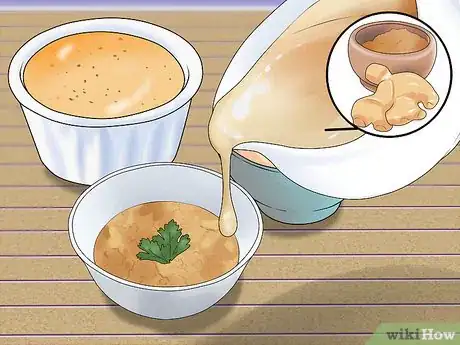This article was co-authored by Courtney Fose, RD, MS. Courtney Fose is a Registered Dietitian and Certified Nutrition Support Clinician at the University of Arkansas for Medical Sciences. She has worked as a Dietitian since 2009, and received her MS in Clinical Nutrition from the University of Arkansas in 2016.
wikiHow marks an article as reader-approved once it receives enough positive feedback. In this case, 100% of readers who voted found the article helpful, earning it our reader-approved status.
This article has been viewed 82,044 times.
Not only is the curcumin in turmeric an anti-inflammatory and an anti-oxidant, it may help prevent cancer and Alzheimer's, lower your cholesterol, and even help with weight control and mental health. In fact, many different cultures in India, Asia, and Africa have been grinding turmeric stems and using the spice in remedies to aid digestion, cure skin ailments, relieve arthritis, and regulate menstruation. There are several ways to incorporate turmeric into your diet, and you can start by adding turmeric to the meals and snacks you already eat!
Steps
Cooking and Seasoning with Turmeric
-
1Supplement curry dishes with extra turmeric. Many pre-mixed curries or packaged curry dishes will contain turmeric, though the quantity of turmeric is often quite small. Simply add more turmeric yourself! While the flavor of turmeric is distinct, it isn't too strong — and it blends perfectly with curry. Add turmeric to taste, but know that a 1/8 teaspoon per serving is a good amount to add to any dish, and will likely not affect the flavor of anything savory.
- Do not expose turmeric to prolonged heat, as curcumin can be rendered inaccessible by excessive cooking. To prevent this, add turmeric later in the cooking process.[1]
-
2Add turmeric to your morning eggs. Fried or scrambled eggs are an ideal dish to eat with turmeric. Use coconut oil to cook your eggs in, as the fat will increase turmeric's bioavailability since it's fat-soluble, and the coconut flavor pairs well with that of turmeric. Don't forget to include black pepper, and a bit of salt may help rounding the seasonings out.
- A great accompaniment to eggs is sautéed kale, which can be prepared in the same pan, in the same way, even scrambled together!
- Add turmeric to the eggs or kale late in the cooking process, or simply dust the meal once you have it plated.
Advertisement -
3Cook lentils with turmeric. Mix green or brown lentils with vegetable stock or water and cook in saucepan at medium heat for around 30 minutes. Use 1 cup of whichever liquid you are using for every 2 cups of lentils. Near the end of the 30 minutes, heat a bit of coconut oil in a separate pan for a minute and stir in 1 teaspoon for each cup of lentils you're cooking. When the lentils are done — per your preference on softness — add the turmeric and oil mixture, as well as some black pepper.
- Curry powder and canned tomatoes can also be added to the lentils while they are cooking.
- Similarly, you can also add cinnamon and cardamom to the oil and turmeric mixture.
- Create a similar dish with chickpeas or garbanzo beans instead of lentils.
-
4Sprinkle turmeric on roasted or pan-fried veggies. Whether cooked in the oven or in a pan, sprinkle turmeric on cooked veggies, along with salt and pepper. Cauliflower, potatoes, and sweet potatoes are especially well-complimented by the flavor offered by turmeric. You can even toss any of these veggies in oil — preferably coconut — before pan frying or roasting in the over. Lemon zest and cilantro will even further enhance such a dish.[2]
-
5Make soup with turmeric. If you already have a go-to soup recipe, consider adding a bit of turmeric near the end of the cook. If you're on the hunt for a new soup, try making spiced carrot and tahini soup.[3]
- Fry carrots, onion, and garlic in a pan with a bit of oil until softened.
- Place the veggies in a pot and add as much vegetable broth as you want, based on preference.
- Add ground coriander, cumin, turmeric, and salt to the mixture and cook for a few minutes on medium heat.
- Add tahini and lemon juice at the end of the cook, and garnish each serving with a turmeric dusting and a sprig of cilantro.
Crafting Healthy Drinks with Turmeric
-
1Boil some turmeric tea. Simmer 1 teaspoon of ground turmeric in 4 cups of boiling water for 10 minutes. Allow to cool to a safe temperature, and add whatever additional spices or sweeteners you prefer. Ginger, honey, lemon, and cayenne pepper are especially enjoyable additions.[4]
- You can also boil a chunk of turmeric in water, perhaps with a chunk of ginger for the same effect. Discard the boiled roots before drinking!
-
2Whip up some “golden milk.” Mix the following ingredients: 1 cup of the milk of your choice, 1 teaspoon of ground turmeric, 1 teaspoon of dried ginger, 1 teaspoon of coconut oil, and 1 dash of black pepper. Microwave in a mug or heat with a saucepan on a stovetop burner set to low.
- Add a sweetener to taste — consider honey, cinnamon, and nutmeg in particular.
- Similarly, make a turmeric milkshake by blending these ingredients, with a banana and ice.[5]
-
3Make an anti-inflammatory smoothie. A smoothie including turmeric, green tea, and berries may prove helpful in fighting inflammation. Make sure to include berries — especially blueberries, cranberries, and/or raspberries — as well as coconut oil to ensure your absorption of the turmeric.[6]
- Blend 1 cup of green tea and 1 cup berries with 1 tablespoon (14.8 ml) of coconut oil, ½ teaspoon of turmeric, ½ teaspoon of ginger, and 1 teaspoon of flaxseed of chia seeds in a blender, along with a banana and ice.
- For a slightly different, equally healthy smoothie option, blend 1 cup of coconut water or milk, a ¼ of an avocado, some pear, apple, or kiwi, ½ teaspoon of turmeric, a banana and ice.
Maximizing the Health Benefits of Eating Turmeric
-
1Mix black pepper into your turmeric jar. Ensure that you're getting the potential health benefits from the curcumin in turmeric by maximizing its bioavailability, which describes how easily your body can process particular nutrients. Curcumin's natural bioavailability is quite low, as it is poorly absorbed, quickly metabolized, and mostly eliminated by your body.[7] Fortunately, you can easily increase the bioavailability of turmeric by consuming it with black pepper.
- Make a mix of the two spices that is about 3% black pepper and 97% turmeric. This way, whenever you add turmeric to anything, you've already got a built-in bioavailability booster.[8]
- About ½ teaspoon mixed into ¼ cup of turmeric should be the perfect ratio.
- Specifically, black pepper contains piperine — which is the chemical that aids your body's absorption of curcumin — by about 2000%![9]
-
2Add turmeric to oil-based sauces and dressings. If pepper isn't your thing, or if you're looking for another way to maximize bioavailability, mix turmeric into coconut, flaxseed, and olive oils. One of the reasons your body gets rid of curcumin so easily is that it's not very water-soluble, and fatty foods can help maintain curcumin in your system long enough for your body to absorb it.[10]
- Add a few dashes of turmeric to your oil-based salad dressings. You can simply add turmeric right to the dressing bottle to avoid forgetting!
- Sprinkle turmeric right onto an avocado, and eat as is.
-
3Make a turmeric veggie dip. Blend cashews, coconut flesh, and olive oil into whatever thickness you prefer for dipping or spreading. You can always add a bit of coconut water to thin the dip. Add garlic, turmeric, and ground ginger to taste. Don't forget to include some black pepper![11]
- Eat the dip with fresh veggies, especially sweet peppers, snap beans, and raw broccoli, as these all contain quercetin, another nutrient that increases the bioavailability of curcumin.
-
4Include turmeric in dishes that contain quercetin. Quercetin is actually a pigment that is commonly found in foods with rich colors — including various fruits and leafy greens. It helps your body process curcumin circuitously, by inhibiting a naturally occurring enzyme in your body that deactivates curcumin.[12]
- Eat more dark red or blue fruits especially, including cranberries, blueberries, and black plums. Red grapes, apples, and other berries contain some quercetin as well.
- Make salads that include red leaf lettuce, raw kale, chicory greens, raw spinach, and onions.
- Pair a meal that contains turmeric with red wine or green tea, as these contain quercetin as well.
Warnings
- If you are pregnant or taking medications, talk to your doctor and pharmacist about including turmeric in your diet.⧼thumbs_response⧽
- Do not actively add turmeric to your diet if you suffer from any gallbladders diseases.⧼thumbs_response⧽
- Turmeric will stain clothing and dishes, so handle the spice carefully.⧼thumbs_response⧽
- Clinical trials regarding the medicinal use of turmeric have yet to be completed. While some studies have proven health benefits in animals, the science regarding health effects on people is nascent.⧼thumbs_response⧽
- Be aware that eating too much turmeric can lead to indigestion, nausea, or diarrhea. If any of these symptoms occur, lessen your turmeric intake.⧼thumbs_response⧽
References
- ↑ http://www.healthyandnaturalworld.com/turmeric-smoothie-recipes-to-boost-bioavailability/
- ↑ http://www.mindbodygreen.com/0-9206/10-ways-to-get-more-turmeric.html
- ↑ http://www.mindbodygreen.com/0-9206/10-ways-to-get-more-turmeric.html
- ↑ http://www.healthy-eating-support.org/how-to-use-turmeric.html
- ↑ http://www.mindbodygreen.com/0-9206/10-ways-to-get-more-turmeric.html
- ↑ http://www.healthyandnaturalworld.com/turmeric-smoothie-recipes-to-boost-bioavailability/
- ↑ http://lpi.oregonstate.edu/book/export/html/465
- ↑ https://www.thekitchn.com/7-ways-to-eat-drink-turmeric-198696
- ↑ http://www.healthyandnaturalworld.com/turmeric-smoothie-recipes-to-boost-bioavailability/




































































